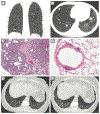Lymphangioleiomyomatosis and Other Cystic Lung Diseases
- PMID: 37055093
- PMCID: PMC10863428
- DOI: 10.1016/j.iac.2023.01.003
Lymphangioleiomyomatosis and Other Cystic Lung Diseases
Abstract
Cysts and cavities in the lung are commonly encountered on chest imaging. It is necessary to distinguish thin-walled lung cysts (≤2 mm) from cavities and characterize their distribution as focal or multifocal versus diffuse. Focal cavitary lesions are often caused by inflammatory, infectious, or neoplastic processes in contrast to diffuse cystic lung diseases. An algorithmic approach to diffuse cystic lung disease can help narrow the differential diagnosis, and additional testing such as skin biopsy, serum biomarkers, and genetic testing can be confirmatory. An accurate diagnosis is essential for the management and disease surveillance of extrapulmonary complications.
Keywords: Amyloidosis; Birt-Hogg-Dubé syndrome (BHD); Cystic lung disease; Light chain deposition disease; Lymphangioleiomyomatosis (LAM); Lymphoid interstitial pneumonia; Pulmonary Langerhans cell histiocytosis (LCH).
Copyright © 2023 Elsevier Inc. All rights reserved.
Figures








References
Publication types
MeSH terms
Supplementary concepts
Grants and funding
LinkOut - more resources
Full Text Sources
Medical

